Magazine
The Dutch Reach
- What is the Dutch Reach?
- Why is it necessary?
- How does it work?
What is the Dutch Reach?
It originated in the NL and ‘The Dutch Reach’ is now a driving practice that is becoming increasingly widely adopted in Europe, and in other parts of the world, as helping to promote increased safety for car drivers and passengers, especially in their behaviour towards two-wheeled road users.
Why is it necessary?
Driving on roads and in places that cyclists frequent is something that motorists are having to contend with more and more, particularly in cities, as urban roads become increasingly cycle-friendly and fleets of instantly rentable bicycles form an increasingly common part of our everyday lives in many major cities around Europe.
How does it work?
So what exactly is the Dutch Reach and why might it save someone from an injury, or worse?
Most of us, when we pull up at a parking space and want to get out of the vehicle, reach for the door handle with the hand that is nearest to the door. We don’t really give it a second thought, but we should, because every year around 60 cyclists are killed in the UK alone, by motorists opening a vehicle door – without fully looking around – straight into the path of a cyclist. Often the cyclist will crash into the door and be thrown from their bicycle, or will swerve to avoid it, perhaps into the path of oncoming traffic. The same danger is present with motorcycles, although their engine noise usually gives more of a warning of their presence.
The Dutch Reach means that you open the car door with the hand furthest away from the door. It ensures you turn your body to face the window, while at the same, stopping you, in the first instance, from opening the door too widely.
The manoeuvre is called the Dutch Reach because it was adopted by Dutch law way back in the 1970s and it has therefore been referenced as such in countries around the world since.
Choosing the Dutch Reach sets off a series of five linked actions: reaching, swivelling, looking back, opening the door more slowly, and then exiting the vehicle facing the traffic. This series of actions should mean that opening the door becomes a safer exercise for cyclists and motorcyclists, but it should help protect your vehicle as well!
Awareness and adoption of the Dutch Reach is growing steadily, not just in Europe, but around the world. The Dutch Reach Project (www.dutchreach.org), which aims to see increased adoption of the practice globally, reports that it has received coverage of the Dutch Reach in use from more than 50 countries – in 39 languages.
In many parts of Europe, drivers are bound by the 1968 Vienna Convention on Road Traffic, whose Article 24 prohibits opening a vehicle door, leaving it open, or getting out of the vehicle without having made sure that you can’t endanger other road users by doing so.
The UK has also implemented a raft of driving regulations that came into force in 2022, aimed at making the roads safer for road users in general. Many were devised to help cyclists in particular, one such being the adoption of the Dutch Reach.
It has now been introduced into the UK Highway Code as a recommendation in Rule 239, making it against the Law not for just the driver, but for any passenger in the vehicle, to open the door in a way that injures or even endangers anyone – an offence known as ‘Car-Dooring’*. You won’t actually be prosecuted for not using the Dutch Reach, but if you don’t, and a Car Dooring incident takes place, whether it is you, or your passenger who is involved, you will face prosecution, as, in the case of it happening with a passenger door, will be the passenger.
The UK may be at the forefront of enshrining the Dutch Reach as part of its legislation, but it is really just a sensible thing to do, for anyone travelling in a car. Therefore, moving forward, if you are the driver in any country, it is a sound idea to make your passengers aware of the Dutch Reach, as well as making it part of your own driving practice.

